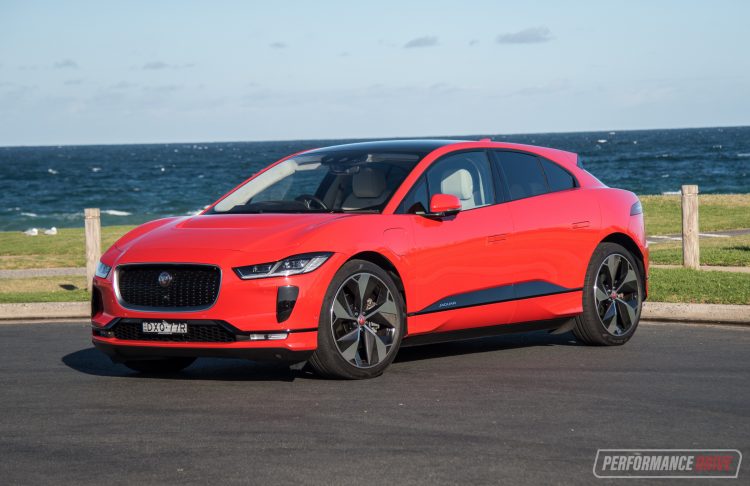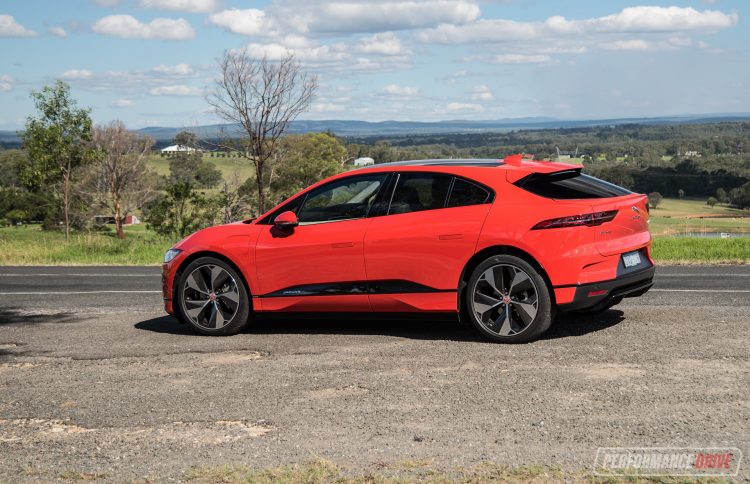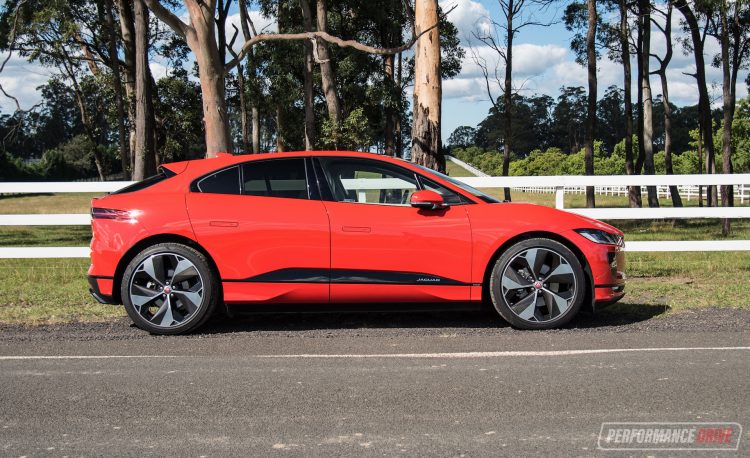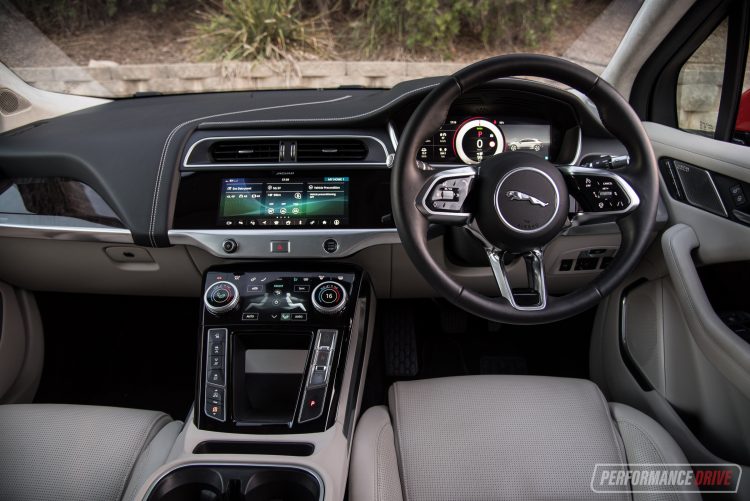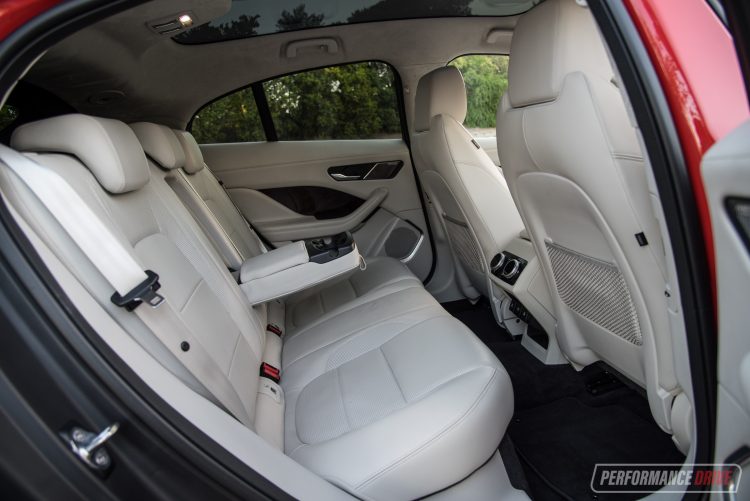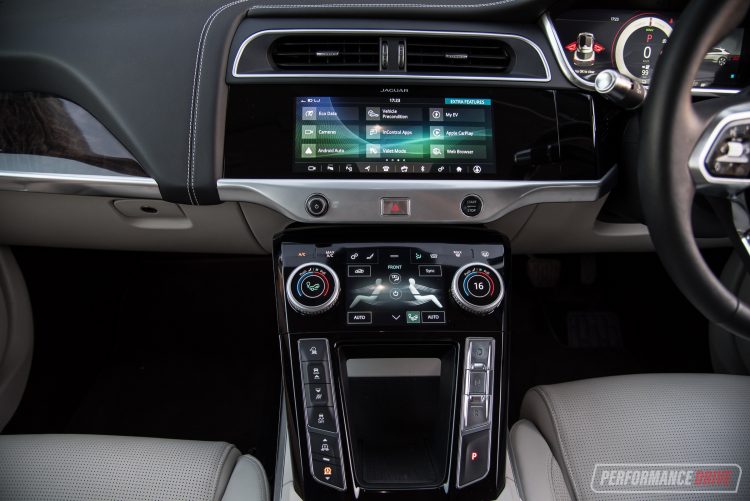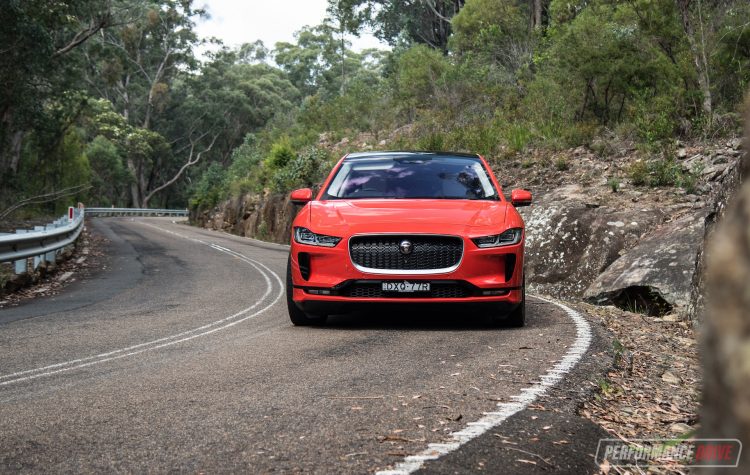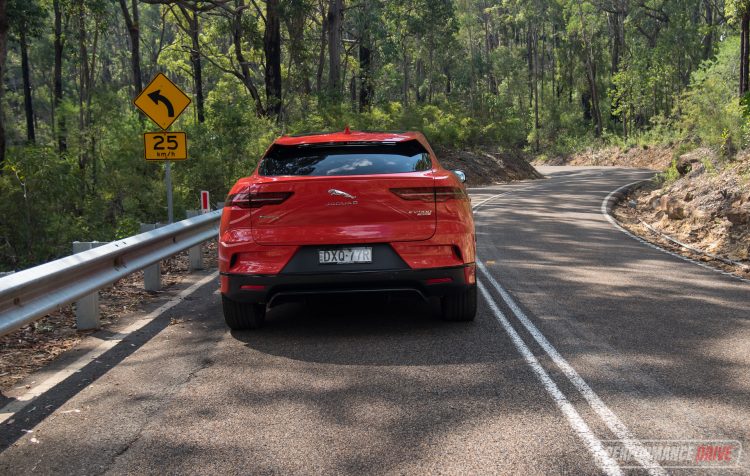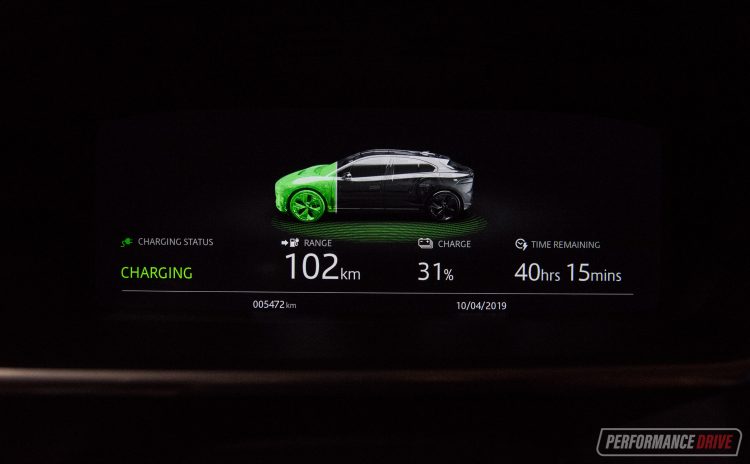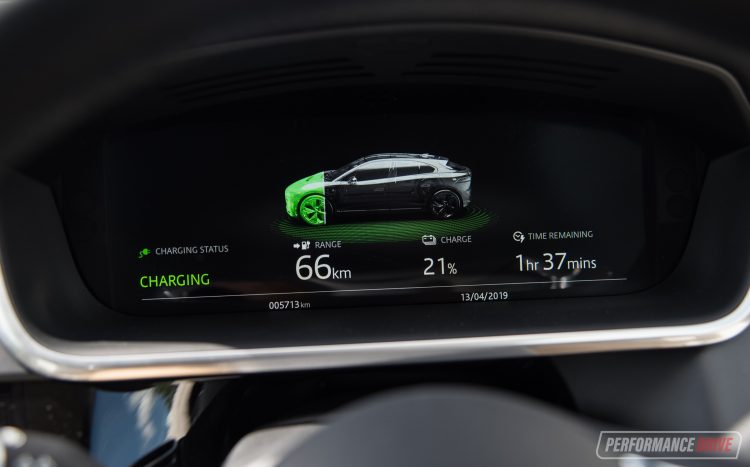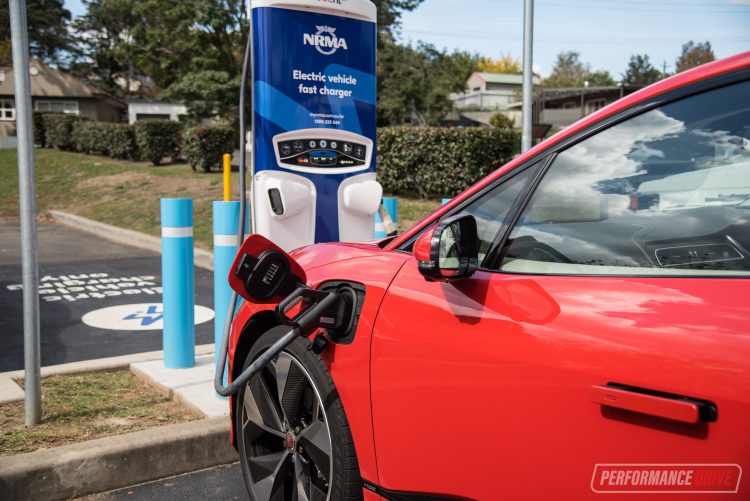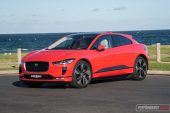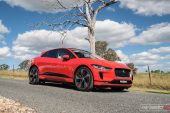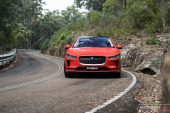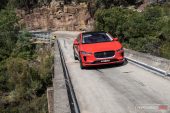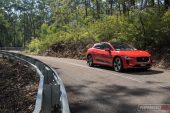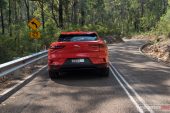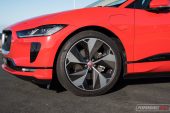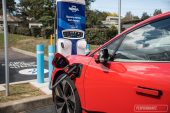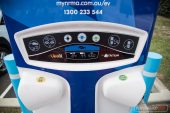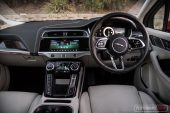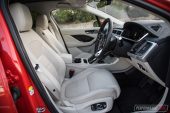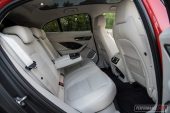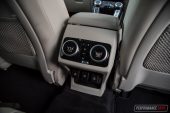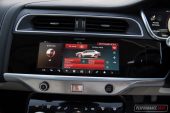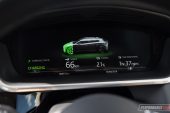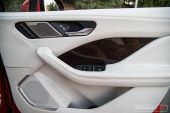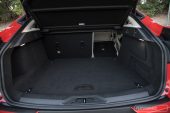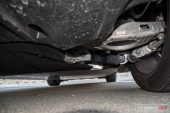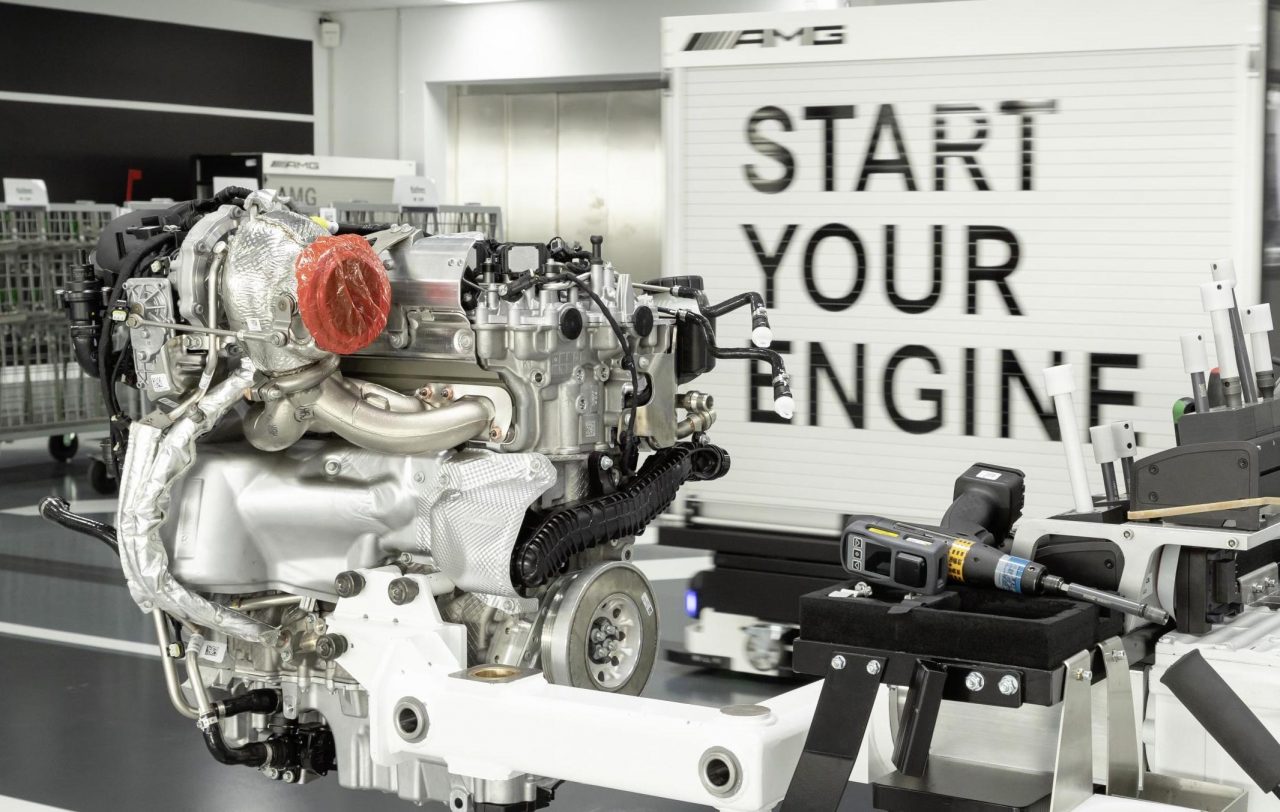Amazed? You should be. Not only has Jaguar managed to create a beautifully-designed electric crossover with the new I-PACE. It’s also managed to beat all of the eager German carmakers to the market.
You see, Audi, BMW, and Mercedes-Benz are all frantically striving to force-feed the market with a mid-size fully electric crossover. Meanwhile, Jaguar has snuck in with the I-PACE. And on first impressions; performance, styling, packaging and technology are all very well executed.
Just one main variant is on sale at the moment, called the EV400. You can get it in S, SE, and HSE trim levels. Here we’re sampling the flagship ‘First Edition’ which is based on the HSE. The cream of the crop, in other words. Prices start at $159,700 for this First Edition, but you can sign for a base model S from $119,000 (excludes on-roads).
2019 Jaguar I-PACE HSE – THE SPECS
[column width=”47%” padding=”6%”]Power source: 90kWh lithium-ion battery, 2 electric motors
Output: 294kW / 696Nm
Transmission: Single-speed auto
Drive type: All-wheel drive
Wheels: F: 20×8.5, 255/50 (optional 22s fitted)
ANCAP: Five stars
Tare weight: 2140kg
Power-to-weight: 7.27:1 (kg:kW)
Recharge: DC 100kW, AC 7kW[/column] [column width=”47%” padding=”0″]Range: 470km (WLTP)/377km (EPA)
0-60km/h: 2.59 seconds*
0-100km/h: 4.62 seconds*
60-110km/h: 2.76 seconds*
1/8 mile: 8.51 seconds at 143.3km/h*
1/4 mile: 13.10 seconds at 172.4km/h*
Max acceleration: 0.956g
100-0km/h braking: 2.77 seconds at 34.74 metres*
Max deceleration: -1.285g
Priced from: $159,700[/column][end_columns]
* Figures as tested by PerformanceDrive on the day. Factory claims may be different
2019 Jaguar I-PACE HSE – THE PACKAGE
So, what is it exactly? It’s pitched as a mid-size SUV. Although it’s probably more a crossover than an SUV in the traditional sense. The body goes for an unusual style. It’s almost sedan. Almost coupe. And almost shooting brake, to some degree. There’s a tiny little boot lip and a raked hatch that gives it a distinctive look. We think Lamborghini has used whatever body style this is with its Urus as well.
In the metal it looks a lot larger than it does on paper. It is a pretty big car, measuring 4682mm long, 1895mm wide, and standing 1558mm tall. However, all of these measurements are slightly smaller than those of the F-PACE SUV. Since it is rather low and wide though it does possess prominent road presence, and really stands out against conventional SUVs.
The I-PACE isn’t really based on any other vehicle within the Jaguar Land Rover umbrella. Instead, it uses a special sandwich type chassis to contain the batteries. A 90kWh battery setup to be precise, and it’s all placed very low in the entire structure. In fact the centre of gravity is some 130mm lower than the centre of gravity in the F-PACE. There’s also a 50:50 weight distribution thanks to the almost-symmetrical running gear.
At the front axle and at the rear axle there is an electric motor to drive the wheels. So yes, it is all-wheel drive. Both motors combine to produce an eyebrow-raising 294kW and 696Nm. This is more than any other mid-size SUV from JLR, except for the upcoming F-PACE SVR which develops 404kW from its supercharged V8.
Adopting this ‘skateboard’ like chassis means the cabin space is fully optimised. There are no transmission tunnels or any running gear at all beneath the seating area. It’s just a completely flat floor underneath and essentially a floor floor inside the car. As a result, the cabin is refreshingly spacious and relaxing. It feels very open yet luxurious thanks to Jaguar’s usual appointments.
You only need to take a glance at the dash fascia to see the level of technology that has been poured into this car. And Jaguar doesn’t do boring. Sitting in the centre of the dash are two touch-screens. And both are exquisitely presented, especially the lower screen which is for the climate control functions.
We’re not a huge fan of the layout of the menus and the overall functionality of this lower screen. We think engineers could have done a better job in making it just a bit easier to navigate. It can get a little confusing while on the go. To adjust anything, first you need to make sure you have the correct section of climate control activated for the screen. And there are loads of different menus to go through. Something as simple as changing the vent mode from windscreen to feet, for example, can be quite a few screen taps away.
However, we adore the way the two main dials have little touch-screens embedded onto them. They change around too. So if you pull the crafted knobs out you can change the fan speed. Or, pressing them in will activate the seat heating control. Another thing we love is when you turn the vehicle off, all of these screens turn off as well, so everything is just blank and black. It looks really clean and clutter-free. It’s this level of attention to detail that really cements it as proper Jag to us.
There’s no shortage of boot space, which is rated at 656 litres. That’s actually more than some mid-size SUVs, including the F-PACE (508L). A front boot is available as bonus storage, but it’s mainly useful for the charging cord.
2019 Jaguar I-PACE HSE – THE DRIVE
Driving an electric vehicle is always a bit of a surreal experience. Even just starting the car; you turn it on like a calculator. There’s no real noise or sense of occasion. Actually, that’s a lie. You will hear the climate system start up and the media screen murmur into existence. It’s then simply a matter of selecting D from the elegant dash stack, and then you’re away.
We were expected Jaguar to lose some of its driving engagement and fun side with the I-PACE. After all it is a heavy vehicle, weighing 2140kg. It’s also Jaguar’s first fully electric vehicle. One might expect it to feel very heavy on the road, with the driving dynamics sacrificed a bit due to the sheer concentration on technology and getting the battery system right. Fortunately, that’s not the case for the former.
This HSE First Edition comes with an otherwise optional air suspension system as standard. And it is sublime. We strongly recommend you tick this option if you’ve missed out on the First Editions (on sale for the first 12 months of market entry). Jaguar engineers have blended a perfect mixture of ride comfort, wheel compression range, while also provided excellent body control and a distinct tautness that Jaguar is renowned for.
Around our usual tight mountain pass, which features plenty of off-camber corners, bumps and dips, and body-upsetting diagonal kinks in the road surface, the I-PACE felt like it literally ironed out these road imperfections. Turn-in is sharp with great feedback returning immediately through the steering wheel. Mid-corner lean is thoroughly managed, even around higher speed sweepers, and bumps do very little to upset the balance or perception of balance and confidence. In short, it really does turn and react like a proper modern Jaguar.
As for the power source. There are not many combustion engines that compare to the instant throttle response and power of an electric motor. It’s like a switch. Nail the throttle and the result in acceleration is as immediate as the flex of your right ankle. We can’t remember driving a petrol or diesel car with this kind of response. Maybe the Lamborghini Huracan and Aventador are pretty similar, if you’re in a decent gear.
From a standing start the feeling of torque is immense. It really pulls your guts around and makes your passengers feel nauseous, momentarily. Jaguar claims 0-100km/h comes up in 4.8 seconds. Using our Vbox we recorded a best of just 4.62 seconds. During testing the Vbox said the car was pulling almost 1g in accelerative force. But believe it or not, it actually feels a lot quicker than that. Due to the instant off-the-mark response from the electric motors, the feeling of g-force makes it seem like a 3.5- to 4.0-second car.
Being all-wheel drive there is no need to worry about spinning off the road or anything like that. The power is delivered seamlessly to the wheels, with no slip whatsoever. We tried putting the car into a tough situation, climbing around a very tight and steep uphill hairpin, with the traction control off. Right at the mid-point of the corner – exactly where you would not usually apply full power – we mashed the throttle, expecting a lot of wheelspin from one of the front wheels. Nope. It just smashed our heads back into the headrests and rocketed up the road. It’s amazing. We guess the heavy weight probably adds a bit of constant downforce for the tyres too.
Now for the least fun part of this car, and indeed any electric car, especially in Australia; charging. If you use the home socket plug, which is really only designed for emergencies, you’ll need over 40 hours to fully charge the car from near empty (below, top image). That’s obviously ridiculous and you would very rarely, if ever, do that. So, the next option is to get a special wall box installed at your home. Using an AC system at 7kW, the time is cut to 10 hours for 80 per cent charge. Using a DC fast-charging socket at 100kW, you’ll need only 40 minutes for 80 per cent charge.
During our test we tried using the free public charge station at the Wollongong University. But we found out (the hard way) that it only has Type 1 sockets –the Jaguar uses Type 2, like a Tesla. The next station is up at Mittagong RSL. It’s provided by the NRMA and it is completely free to use, for now. This may change in the future as more of the population adopt electric vehicles. The charging experience was pleasant enough and we even had a chat to a Tesla owner that rocked up just as our charge was almost complete. Being a single station though, we suspect there might be some lining up in the future.
For us, the charging isn’t really the fault of the I-PACE. If you buy one you’ll no doubt get a wall box installed at your home and you’ll probably rarely use or rely on a public station. What would make this whole concept more digestible would be to simply have a longer range. The I-PACE is rated at 470km on the WLTP test cycle. However, the highest we saw the gauge was around 390km.
Using things like the air-conditioning and the radio and so on does sap some of the charge. But these features shouldn’t be a sacrifice in our opinion. If the range was around 700-800km it would be perfect. You could commute to work every day of the week with no problem, even though you’d probably charge every night anyway. But, you could also comfortably go for a nice drive up or down the coast – and use the air-conditioning – and not have to worry about range anxiety.
2019 Jaguar I-PACE HSE – THE VIDEOS
2019 Jaguar I-PACE HSE – THE VERDICT
The I-PACE proves electric cars can be beautiful and can be built with passion. And that applies to the interior and features, exterior design, and driving dynamics. No, it doesn’t produce a gnarly soundtrack, and it can be a bit of a pain to recharge. But as a first crack at the electric vehicle Jaguar has nailed this. It drives so nicely, and it is properly fast. We look forward to seeing how Jaguar progresses from here in this field.
[column width=”47%” padding=”6%”]PROS:
– Interior blends elegance, technology, and practicality perfectly
– Glorious ride and wheel control with optional air suspension
– Unique and attractive exterior design
– It’s bloody fast
– Jaguar is quick to the market, from concept to production
[/column] [column width=”47%” padding=”0″]CONS:
– Long charge times (in Australia)
– Slightly overpriced compared with equivalent petrol Jaguar
– Complex and attention-consuming climate control
– Daunting options list[/column][end_columns]
As always, if you’re thinking about buying a new car don’t forget to click here to speak with our car buying specialists.
